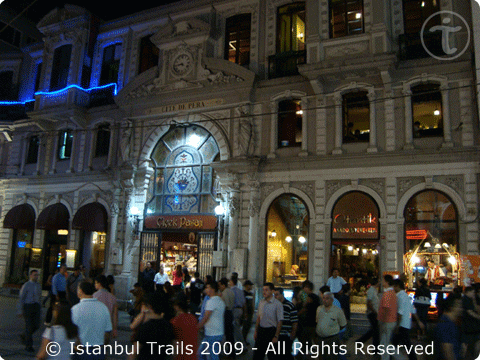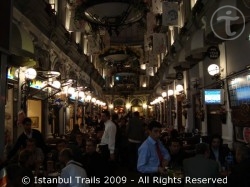In the days that the Orient Express still rolled into Istanbul, the Flower Passage (Çiçek Pasajı) was the most glamorous address on Istiklal Caddesi – or the whole Beyoğlu district for that matter. You can find it almost halfway Istiklal Caddesi, marked ![]() on Map with Tourist Attractions in the Modern Part of Istanbul
on Map with Tourist Attractions in the Modern Part of Istanbul
These days unfortunately have long gone. The theatre as well as the stylish shops and flats have been replaced by mediocre restaurants. Luckily its extraordinary architecture remains largely intact, making a small visit to the Flower Passage worthwhile.

Istanbul’s Most Important Cultural Center
The land of the Flower Passage was originally occupied by the famous Naum Theatre. Mihail Naum, the owner and administrator of the Naum Theatre, bought the building of Bosco Theatre. After small renovations the Théatre de Péra was opened in 1844. Lucrezia Borgia was the first opera that was staged.
The wood theatre building had to be rebuilt after a big fire and opened in 1849 as Théatre Italien Naum. Sultan Abdülhamid II and Sultan Abdülaziz of the Ottoman Empire attended several operas that were hosted there. Even before it was staged in Paris, Giuseppe Verdi’s famous opera II Trovatore was staged in this theatre which had become one of the most important cultural centers of Istanbul and Europe.
From Theatre to Flower Shops
Due to the great fire of Pera in 1870, the Naum Theatre collapsed. A Greek banker Hristaki Zargos bought the land and built a shopping arcade with flats designed by an Italian architect Cleanthy Zanno. There were 24 shops and 18 luxurious flats. The shopping arcade was called Hristaki Pasajı and the whole building was called Cité de Pera.
In the first years of the passage there were various shops, among which Acemyan’s tobacco shop, Maison Parret and Vallaury’s patisserie, Pandelis’s flower shop, Schumaher’s bakery, Keserciyan’s tailor shop, Yorgo’s tavern and Sideris’s fur shop.
In 1908 the building was bought by the Ottoman Grand Vizier Sait Paşa and it became known as the Sait Paşa Passage. After the 1917 Revolution of Russia, many noble Russian women, including baronesses, came to Istanbul and opened flower shops in Cité de Pera. Because of the presence of all those flower shops, the place became a flower auction place as well. Today people still refer to the arcade as the Çiçek Pasajı.
Çiçek Pasajı Today
 Starting from the 1940s more and more pubs, wine houses and taverns opened their doors in the Çiçek Pasajı, which gradually made the florists and residents of the flats move out. Only the name of the passage survived.
Starting from the 1940s more and more pubs, wine houses and taverns opened their doors in the Çiçek Pasajı, which gradually made the florists and residents of the flats move out. Only the name of the passage survived.
The building underwent a major renovation in 1988 and re-opened with its restaurants, taverns and pubs. In 2005 the roof and all the other visual parts were restored. Today, with its brilliant architecture, the Flower Passage is still one of the most stylish buildings of Beyoğlu. According to a recent poll, the Flower Passage is the first thing that comes to ones mind when they think of Beyoğlu.
Comments on this entry are closed.